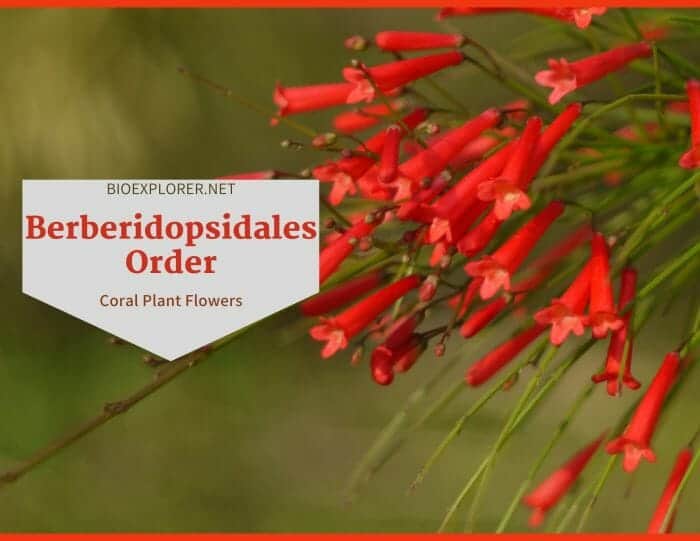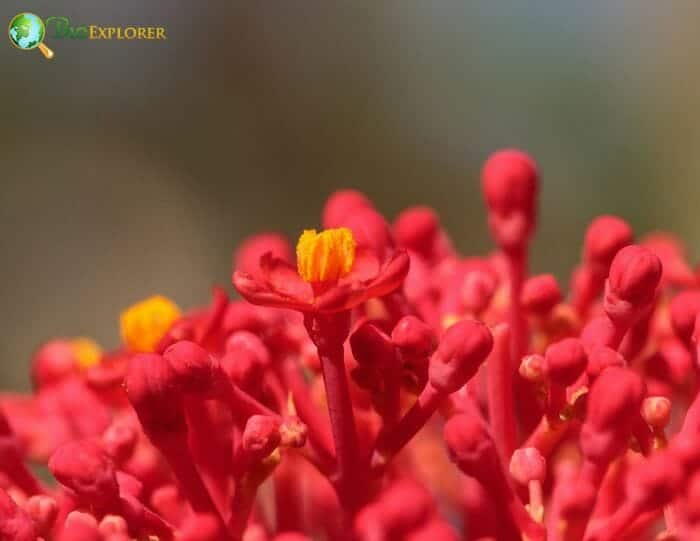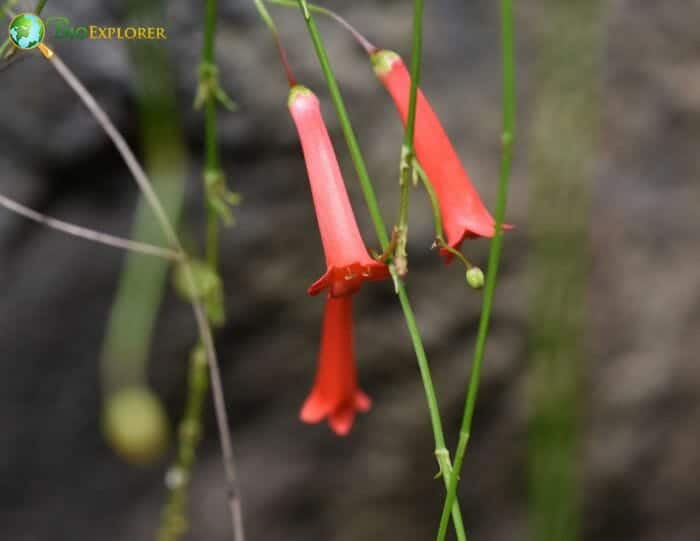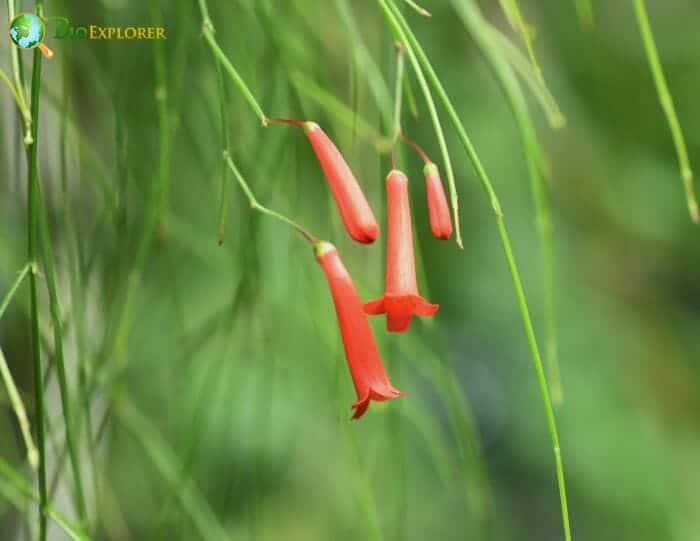
Berberidopsidales is a small order of flowering species under the clade of the core eudicots. The woody evergreen dicotyledonous plants are distributed in eastern Australia and Chile. The species of Berberidopsidales possess crystals, usually have 5-merous floral parts and usually small flowers.
The Berberidopsidaceae hermaphrodites and the only species of Aextoxicaceae undergo entomophilous syndrome. Coral plant and Olivilla are among the only 4 species of Berberidopsidales.
Table of Contents
Berberidopsidales Families
Berberidopsidales comprises 2 families, 3 genera and 4 species.[1] Morphological differences exist between the families, even within the family members. However, molecular biological analyses placed them together in the same order.
- Aextoxicaceae (Olivillo family).
- Berberidopsidaceae (Coral plant family).
![]()
Berberidopsidales Distribution

The 2 genera and 3 species of the family Berberidopsidaceae are distributed to eastern Australia and Chile. The only species of family Aextoxicaceae is also found in Chile.
![]()
Berberidopsidales Characteristics

The placement of Berberidopsidaceae with Aextoxicaceae in one order is unexpected since the species under the families are morphologically different. However, their existence under Berberidopsidales is through the similarities in their molecular data. The following are the characteristics shared by the members of this order.
- Plant type: This order consists of large trees, lianas, or climbing plants.
- Stem: The two families have the same wood characteristics[2] under light and scanning electron microscopy.
- Leaves: The leaves are simple, exstipulateWhat is exstipulate?Without stipules; Stipule is a small structure of appendage found at the base of some leaf petioles., alternate subopposite, and petiolate. The petiole bundles of the members are annular. The stomata of the species are cyclocytic. They are surrounded by subsidiary cells in a narrow ring around the stoma. The members under Berberidopsidales possess crystals presumably of calcium oxalate.
- Flowers and inflorescences: The flowers are small, and plants are hermaphrodites or dioeciousWhat is dioecious?Pertaining to plants, individuals of which bear either staminate or pistillate flowers, but not both.. The flowers are solitary or aggregated in racemes.
- Sepals and Petals: Flowers have 5 sepals and 5 petals.
- Stamens and Carpels: The stamen is 5 (1 whorl), or 5-13 (1 whorl), or 12-75 (densely arranged). The gynoecium is syncarpousWhat is syncarpous?Having united carpels. Contrast apocarpous. with carpels (Aextoxicaceae). Their filaments are stout. The style is present.
- Ovary and Fruits: The ovary is superior. The fruit is a berry or a drupe.
- Seeds: Their seeds are large and endotestal.
![]()
Berberidopsidales Flowers and reproduction

The sole species of Aextoxicaceae has unisexual and actinomorphic flowers in hanging racemes.
- The flowers are pentamerousWhat is pentamerous?Having parts in fives or multiples of five.. They have 5 sepals, 5 petals, and 5 stamens. The stamens are situated opposite the sepals. The female flower has 2 carpels (fused), and the ovary is bilocular.
- The nectaries of Aextoxicon are receptacular. The flowers of this species possess a sweet honey-like smell. Research conducted[3] showed that the tiny flowers of Aextoxicon undergo entomophilous syndrome, and the seeds are dispersed by birds.
- Berberidopsidaceae[4] are pendent, small, hermaphrodites, and partially acyclic. The flowers can be solitary (axillary) or aggregated in racemes (terminal or axillary). The flowers possess free hypanthium.
- The calyxWhat is calyx?A collective term for all the sepals of a flower; the lowermost whorl of floral orgrans (Plural form is calyces). and the corollaWhat is corolla?A collective term referring to the petals of a flower. are free. The perianth is distinct in Streptothamnus, while there is a sequential intergrading of the sepals and the petals in Berberidopsis. The flowers in this family can be sepaloid or petaloid.
- The Streptothamus comprises 5 sepals in a polysepalous state. The Berberidopsis genus has 5 polypetalous petals in the corolla. The petals are sessile in red, white to cream, or red to pink.
- The coral plant or Berberidopsis corallina attracts butterflies and other pollinators.
![]()
Berberidopsidales Family differences
Aextoxicaceae
- The members are large trees with an alternate to subopposite leaves. The leaves are simple, petiolate, non-sheathing, and exstipulate. The lamina and the lamina margins are entire.
- The species undergo the development of secondary thickening from the conventional cambial ring. The stem’s xylem possesses tracheids, and there is an absence of vestured pits in the vessels.
- The plants are dioecious.
- The flowers are small and aggregated in racemes. The flowers are calyptrate and regular. There are 5 sepals (polysepalous) and 5 petals (polypetalous).
- The stamen is also 5 in 1 whorl, opposite the sepals.
- The gynoecium has 2 carpels; syncarpous with a superior ovary. The placentation is apical.
- The fruit is a non-fleshy, indehiscent drupe with 1 seed. The seed is endospermic.
![]()
Berberidopsidaceae
- The members are lianas or climbing plants with small to medium-sized leaves. Leaves are simple, petiolate, alternate, and spiral. They can be herbaceous or leathery. The lamina is entire, and lamina margins are entire or coarsely toothed. They are exstipulate.
- The leaf lamina of the members is dorsoventral. There are crystals in the mesophyll. The phloem transfer cells are absent in the minor leaf veins.
- The species possess homogeneous or heterogeneous pith. The B. corallina develops secondary thickening from the conventional cambial ring.
- The plants under Berberidopsidaceae are hermaphrodites.
- The flowers are small and pendent. They exist in solitary or aggregated in racemes.
- There are 5 sepals and 5 petals; free. They may be distinct in the perianth, or the sepals and petals are sequentially intergrading.
- The androecium is arranged in 1 whorl with 5-13 stamens or densely arranged in 12-75.
- The gynoecium is syncarpous with a superior ovary. The placentation is parietal.
- The fruit is a fleshy and indehiscent berry. The seeds are many and endospermic.
![]()
Berberidopsidales Example species
Berberidopsidales only has 4 species.
- Coral plant[5] – The plant is ornamental. The leaves are used for making baskets.
- Olivillo – The plant possesses good ornamental value.
- Montane tape vine
- Streptothamnus moorei
![]()











